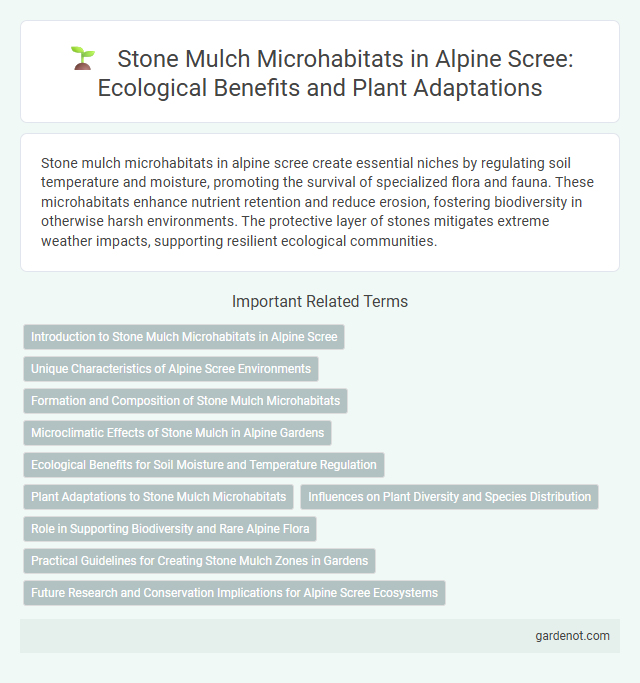Stone mulch microhabitats in alpine scree create essential niches by regulating soil temperature and moisture, promoting the survival of specialized flora and fauna. These microhabitats enhance nutrient retention and reduce erosion, fostering biodiversity in otherwise harsh environments. The protective layer of stones mitigates extreme weather impacts, supporting resilient ecological communities.
Introduction to Stone Mulch Microhabitats in Alpine Scree
Stone mulch microhabitats in alpine scree provide crucial thermal insulation and moisture retention for specialized flora and fauna. These rock fragments create stable microclimates that buffer extreme temperature fluctuations and reduce soil erosion. Such conditions promote biodiversity and support unique ecological communities adapted to harsh alpine environments.
Unique Characteristics of Alpine Scree Environments
Alpine scree environments feature stone mulch microhabitats characterized by loose, angular rock fragments that create highly porous and well-drained substrates, promoting rapid water infiltration and temperature fluctuations. These microhabitats support specialized flora and fauna adapted to extreme conditions such as low nutrient availability, intense solar radiation, and frequent freeze-thaw cycles. The dynamic nature of alpine scree, with constant rock movement and erosion, contributes to a mosaic of microclimates essential for biodiversity persistence in high-altitude ecosystems.
Formation and Composition of Stone Mulch Microhabitats
Stone mulch microhabitats in alpine scree form through the natural accumulation of angular rock fragments derived from freeze-thaw weathering and mechanical disintegration of bedrock. This composition predominantly includes coarse rock debris such as granite, schist, or quartzite, creating porous substrates that regulate moisture and temperature fluctuations. These microhabitats provide critical shelter for specialized flora and fauna by stabilizing microclimatic conditions in otherwise harsh alpine environments.
Microclimatic Effects of Stone Mulch in Alpine Gardens
Stone mulch in alpine gardens creates a microhabitat that moderates temperature fluctuations by absorbing heat during the day and releasing it at night, enhancing plant survival in harsh conditions. This microclimatic effect reduces soil moisture evaporation, maintaining consistent hydration levels crucial for alpine species. The thermal buffering properties of stone mulch support the growth of sensitive alpine plants by providing protection against frost and extreme temperature variations.
Ecological Benefits for Soil Moisture and Temperature Regulation
Stone mulch in alpine scree environments enhances soil moisture retention by reducing evaporation rates and buffering temperature fluctuations, creating a stable microhabitat for plant roots. The rocky surface moderates soil temperature extremes, protecting soil biota and facilitating nutrient cycling essential for alpine vegetation growth. This microhabitat supports biodiversity by maintaining adequate moisture and thermal conditions critical for seedling establishment and microbial activity.
Plant Adaptations to Stone Mulch Microhabitats
Plants in alpine scree environments develop specific adaptations to thrive in stone mulch microhabitats, such as shallow root systems that anchor securely between loose rocks, optimizing water absorption while avoiding erosion. These plants exhibit drought tolerance through waxy or hairy leaf surfaces that minimize transpiration and reflect solar radiation. Specialized nutrient uptake mechanisms allow them to extract limited minerals from mineral-poor substrates, ensuring survival in harsh, rocky alpine conditions.
Influences on Plant Diversity and Species Distribution
Stone mulch microhabitats in alpine scree significantly influence plant diversity by stabilizing soil temperature and moisture, creating favorable conditions for seed germination and root establishment. The uneven distribution of stones leads to microclimatic variations that support niche specialization, promoting a higher diversity of plant species adapted to distinct microenvironments. These microhabitats also act as physical barriers against erosion and herbivory, affecting species distribution patterns by enabling less competitive or more sensitive plants to survive and colonize barren scree slopes.
Role in Supporting Biodiversity and Rare Alpine Flora
Stone mulch in alpine scree creates a crucial microhabitat by regulating soil temperature and moisture, promoting the survival of rare alpine flora such as Saxifraga and Androsace species. This microenvironment supports biodiversity by providing shelter for invertebrates and microfauna, which facilitate nutrient cycling and pollination. The stable conditions within stone mulch patches enable specialized plant communities to thrive in otherwise inhospitable alpine scree landscapes.
Practical Guidelines for Creating Stone Mulch Zones in Gardens
Stone mulch zones in gardens enhance moisture retention and temperature regulation, creating a favorable microhabitat for alpine scree plants. Use angular, locally sourced stones to mimic natural scree conditions while ensuring proper drainage to prevent root rot. Position stones strategically around plant bases to protect roots and reduce soil erosion, promoting healthy growth in harsh environments.
Future Research and Conservation Implications for Alpine Scree Ecosystems
Future research on alpine scree stone mulch microhabitats should prioritize understanding their role in soil moisture retention, seed germination, and microclimate regulation to enhance ecosystem resilience. Conservation strategies must integrate the preservation of these microhabitats to support endemic flora and fauna facing climate change stresses. Long-term monitoring and functional trait analysis will improve adaptive management of alpine scree ecosystems under environmental shifts.
Stone mulch microhabitat Infographic

 gardenot.com
gardenot.com